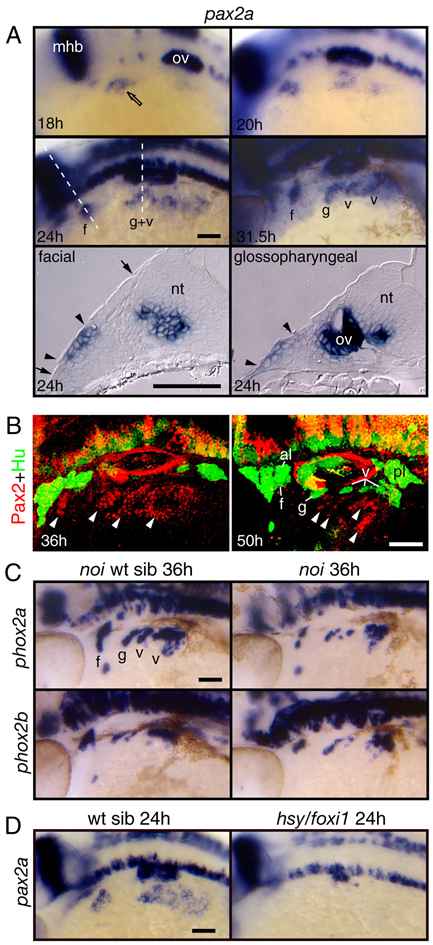Fig. S1 Pax2a is expressed in EB placodes and is required for EB placode development. (A) Expression analyses of pax2a at 18, 20, 24 and 31.5 hpf. Whole-mount panels are lateral views of the embryos; transverse sections are at the level of the facial placode and glossopharyngeal placodes. pax2a expression begins in the presumptive facial placode at 18 hpf (open arrow). At 20-24 hpf, its expression extended caudally to include presumptive glossopharyngeal and vagal placodes. Between 28 and 31.5 hpf, pax2a expression was maintained in the individual placodes and internalized neuroblasts. Transverse sections at 24 hpf revealed the presence of pax2a mRNA (arrowheads) in the thickened columnar epithelium (the extent of the thickened epithelium is marked by arrows), a hallmark of cranial placodes. Interestingly, the facial domain of pax2a expression was restricted to the ventral part of the epithelium, indicating that the EB placodes are restricted to the ventral part of the competent ectoderm. (B) Zebrafish embryos were collected at 36 and 50 hpf, and processed for immunolabeling with Pax2 (red) and Hu (green) antibody. Pax2a protein (arrowheads) was downregulated in the differentiated Hu-positive EB neurons. (C) Pax2a activity is required during EB ganglia development. The zebrafish pax2a mutant no isthmus (noi) displayed a reduction in EB neurons. (D) Foxi1 activity is required for pax2a expression. Notice that pax2a message is absent in the hsy/foxi1-mutant embryos. a, acoustic ganglion; al, anterior lateral line ganglion; f, facial placode or ganglion; g, glossopharyngeal placode or ganglion; mhb, midhindbrain boundary; nt, neural tube; ov, otic vesicle; pl, posterior lateral line ganglion; t, trigeminal ganglion; v, vagal placode or ganglion. Scale bars: 50 μm.
Image
Figure Caption
Figure Data
Acknowledgments
This image is the copyrighted work of the attributed author or publisher, and
ZFIN has permission only to display this image to its users.
Additional permissions should be obtained from the applicable author or publisher of the image.
Full text @ Development

